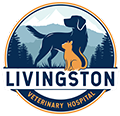Choosing the right food for your furry friend is an important, but often confusing, pet ownership responsibility. With the overwhelming variety of pet foods available, understanding how to read a pet food label is essential to ensure your four-legged friend receives the proper nutrients for optimal health. Our Livingston Veterinary Hospital team walks you through the key information on pet food labels, helping you make informed decisions about your pet’s nutrition.
Pet food ingredient list: Protein first
The ingredient list contains some important information you will need to sift through when comparing diets. Ingredients are listed in descending order by weight, including water weight, with the heaviest components listed first. Meat protein sources, such as chicken or beef or a specific meat meal should be listed first. A meat meal, such as chicken meal, is simply chicken that has been dried and ground up.
Keep in mind that the ingredient list does not contain information on an ingredient’s quality, nor if an ingredient is included in a large enough amount to provide nutritional benefits. For example, you may be impressed that a pet food contains superfoods, such as kale, blueberries, wheatgrass, and avocados, but they may be in such minuscule amounts that they provide almost no health benefits.
Search for foods that clearly identify their ingredients rather than using vague terms. Choose chicken meal over poultry meal, salmon oil over fish oil, and beef by-products over animal by-products.
Pet feeding guidelines: Recommendations, not rules
A pet food label’s feeding guidelines should be straightforward and tell you the amount you should feed your pet. However, these are recommendations only, not set-in-stone rules. While the guidelines provide a good starting point for determining the amount you should feed your pet, a better method is to calculate your furry pal’s caloric requirements.
Guaranteed analysis: Essential nutrients your pet needs
A pet food label’s guaranteed analysis section provides information about the diet’s nutrient content. This typically includes protein, fat, fiber, and moisture percentages. While reputable manufacturing companies strive to adhere to the percentages listed on the labels, they face no repercussions if substantial differences exist. For example, if a diet is labeled as containing a 27% protein minimum, the food can contain a much higher percentage without legally needing to disclose that fact.
In general, the guaranteed analysis is one of a pet food label’s least important components. The guaranteed analysis provides little useful information unless you are in search of a diet high in moisture.
Nutritional adequacy statement: Pet food quality assurance
Pet foods are regulated by the Food and Drug Administration (FDA) for safety, and by the Association of American Feed Officials (AAFCO), which monitors adherence to established regulations. The nutritional adequacy statement indicates whether a pet food meets the minimum nutritional requirements established by regulatory bodies. Look for phrases such as complete and balanced or meets the nutritional levels established by the AAFCO for life stage.
Life stage designation: Age-appropriate nutrition for your pet
Pet foods are often labeled for specific life stages, such as puppy, adult, or senior. Choose a product appropriate for your pet’s age and activity level. Feeding a puppy formula to an adult dog may result in excess nutrient intake, while a senior formula might lack the necessary nutrients for a growing puppy. The AAFCO does not have a nutritional standard for senior pet diets, so always check with your Livingston Veterinary Hospital veterinarian when switching your older pet’s diet to ensure the food meets your furry pal’s changing needs.
Misleading marketing: Unregulated terms on pet food labels
Pet food labels often feature marketing terms that can be misleading. Be wary of phrases, such as natural, premium, or holistic, as these terms are not regulated and may not reflect the ingredients’ actual quality. Focus on the nutritional information for a more accurate assessment.
Avoiding pet allergens: Ingredient analysis

If your pet has allergies or sensitivities, carefully read the ingredients list to identify potential triggers. Food allergens most commonly include chicken, lamb, beef, fish, dairy, eggs, wheat, and soy.
Keep in mind that ingredients can be listed in a misleading manner, making it challenging to completely eliminate a protein without speaking with the diet’s manufacturer. Generic, vague terms, such as animal by-product meal or poultry fat, can make it difficult to rule out diets that will trigger an allergic response in your pet. Select a hypoallergenic or limited-ingredient diet if your pet has specific dietary requirements.
Decoding a pet food label may seem daunting at first, but by following the tips we have provided here, you can make informed choices that positively impact your pet’s health and wellbeing. By understanding ingredient lists’ significance, guaranteed analysis, nutritional adequacy statement, and other key components, you can navigate the pet food aisle confidently and provide your furry friend with the nutrition they need.
Determining which diet suits your pet’s health needs best can be challenging. If you’re stuck wandering the pet food aisles, schedule a nutrition consultation with our Livingston Veterinary Hospital team.







Leave A Comment